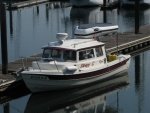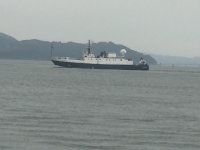Today we spent a couple hours as the guest of Dr. Loren Davis, an Antropology professor at Oregon State University, aboard the exploration vessel Nautilus. He will be leading an expedition aboard this ship to search for early submerged landscapes and the archaeological sites they may hold near Heceta Bank off the central Oregon coastline.
Loren is my nephew and he invited Lois, me, his mom (my sis) and my daughter aboard for a tour of the amazing ship and a brief lecture on the studies they are doing offshore.
Here is the ship tied to Pier 1 at the Port of Astoria:
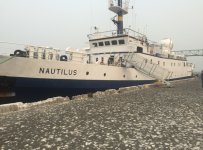
This is the smaller of two Remotely Operated Vehicles. These ROV units, dubbed Argus and Hercules, were used to explore the wreck of the Titanic and many other historical undersea sites.
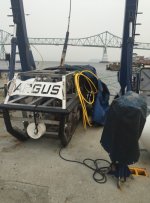
This is the best shot I could get of the larger ROV that does the real work undersea. The smaller ROV is tethered to the ship and the larger one is tethered to the smaller. This arrangement helps the working ROV remain independent and unaffected by the movement of the ship on the surface.

This is the antenna array that transmits the data collected by the ROV to a satellite in space and back to earth where it can be viewed on the internet a mere 20 seconds later than live at www.Nautiluslive.org.
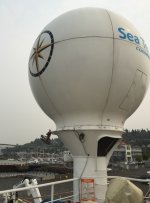
And this is my sister's kid, Loren G. Davis, Ph.D.
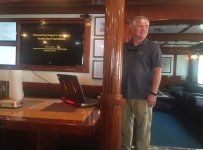
I didn't get any good pictures of the control room where they operate the ROVs because I was too busy paying attention to the fascinating discussion by the team member who led our tour. The same goes for the bridge. The instruments at the helm are a bit more sophisticated than the ones on my boat! There are thrusters and stabilizers on the hull which are controlled at the helm with the aid of computers and GPS to allow the ship to remain at a precise spot on the water regardless of sea state, or to move with precision along a mapped course.
It is all fascinating stuff. If you go to the www.nautiluslive.org website you can follow along with the expedition.
Loren is my nephew and he invited Lois, me, his mom (my sis) and my daughter aboard for a tour of the amazing ship and a brief lecture on the studies they are doing offshore.
Here is the ship tied to Pier 1 at the Port of Astoria:

This is the smaller of two Remotely Operated Vehicles. These ROV units, dubbed Argus and Hercules, were used to explore the wreck of the Titanic and many other historical undersea sites.

This is the best shot I could get of the larger ROV that does the real work undersea. The smaller ROV is tethered to the ship and the larger one is tethered to the smaller. This arrangement helps the working ROV remain independent and unaffected by the movement of the ship on the surface.

This is the antenna array that transmits the data collected by the ROV to a satellite in space and back to earth where it can be viewed on the internet a mere 20 seconds later than live at www.Nautiluslive.org.

And this is my sister's kid, Loren G. Davis, Ph.D.

I didn't get any good pictures of the control room where they operate the ROVs because I was too busy paying attention to the fascinating discussion by the team member who led our tour. The same goes for the bridge. The instruments at the helm are a bit more sophisticated than the ones on my boat! There are thrusters and stabilizers on the hull which are controlled at the helm with the aid of computers and GPS to allow the ship to remain at a precise spot on the water regardless of sea state, or to move with precision along a mapped course.
It is all fascinating stuff. If you go to the www.nautiluslive.org website you can follow along with the expedition.

